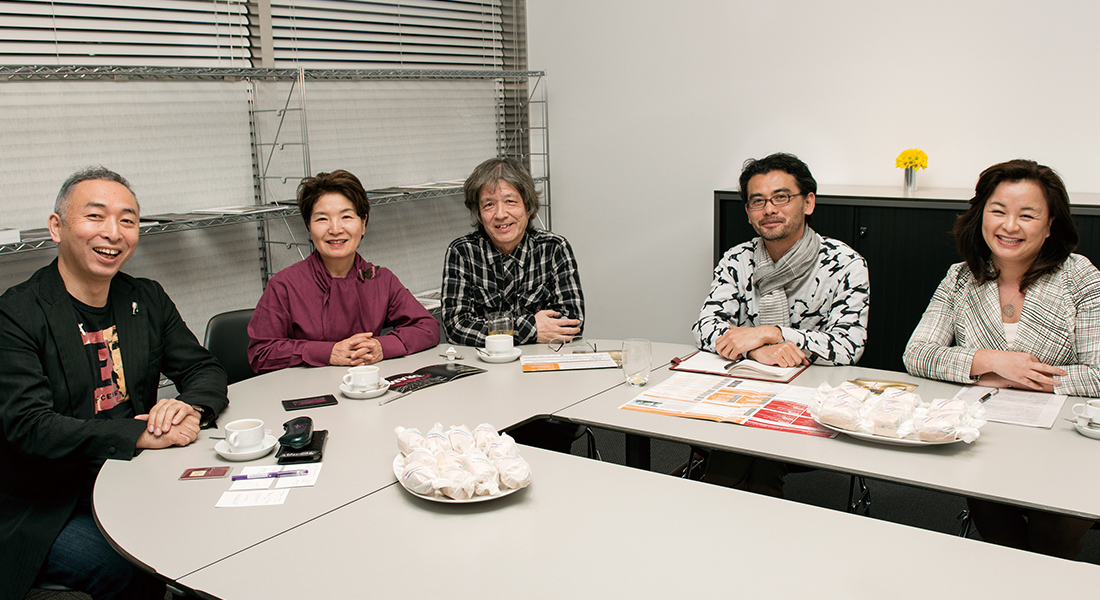Feature

ROUND TABLE2018.12.21
What we wanted to convey
through ENLIGHTEN ASIA IN JAPAN #3
Lighting Designers/Hiroyasu Shoji, Tatsuoki Nakajima,
Reiko Chikada, Miki Matsushita, and Izumi Okayasu
Words to express lighting
| Shoji | More businesses directly commission projects from project owners. The direct appointment of three professions—lighting designers, interior designers, and landscape architects—has significantly increased. But like always, projects commissioned by architects surely account for the most. |
| Matsushita | In my case, I’m directly appointed by clients in many projects. I think such clients are better versed, simply because they are interested in lighting and they pick a lighting designer, instead of entrusting an architect or coordinator. They also listen carefully to my presentations and understand them. |
| Nakajima | I heard a story from a Chinese designer about a problem regarding concept creation—a stage prior to presentation. First, an attractive looking drawing is made with CG. Then in most cases, lighting that appears similar to the drawing is made in cooperation with manufacturers and others. I’m concerned that Japan may be heading toward a similar situation. In a way, CG is perhaps easier to understand, since the general public doesn’t see the professional factors of lighting, such as the psychological and physiological aspects. |
―There are similar cases in interior design. After a designer makes a CG perspective drawing and hands it to a builder, the builder would be able to handle the rest. Japanese builders can do such a thing because they are excellent.
| Okayasu | I feel bitter about the situation, where an architect or name of a building comes first, and lighting is regarded as accessories [laughs]. Ideally, an excellent lighting design is added to an excellent building. But it doesn’t always happen. There are some hopeless buildings and interiors.
Sometimes, an outstanding lighting design is added to transform such spaces into amazingly splendid architectural spaces. I wonder if such examples can be archived. In other words, a pure archive of lighting examples that don’t rely on buildings. There should be an evaluation axis. Like, this lighting is evaluated like this for each axis, and therefore it looks cool. I think if people who create things can see a poorly evaluated factor, it might be easier for them to cover it up. |
| Shoji | I think it’s necessary to establish a solid system to translate the value and world-view of lighting into words. Take the example of wines. Typically, wines used to be locally made and consumed in the local and nearby areas. Wines became common drinks in Japan only around 1980. The presence of sommeliers is behind the popularization of wines. They translate the value of wines into words, explaining “this wine has the color of lemony straw” or “slightly brownish orange.” The expressions also have meaning. If a wine described as “slightly brownish orange” is cabernet sauvignon, it has more of a tart taste. Characteristics and values of tastes and flavors can also be verbally expressed. How about lighting? Instead of describing whether a light is bright or dim, we need to convey what the brightness or dimness is like—is it a comfortable brightness, or is it an annoying brightness? The only criteria of the general public is “bright is good, and dim is bad.” If it’s stated as “relaxing dimness,” dimness is positively evaluated, right? For an explanation of color temperature, “incandescent” will be used, instead of kelvin. |
| Matsushita | Verbal expression of lighting designs is very important. |
| Shoji | Conveying something is truly difficult. Ms. Motoko Ishii told me: “It’s only right to hold seminars properly. Have a party at the end that will be suitable for lighting designers.” We planned something a little bit different from symposiums and seminars. I believe it turned out to be an event that conveyed lighting designs and lighting designers. |

